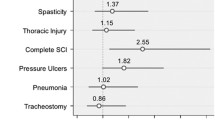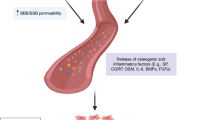Abstract
Purpose of Review
Heterotopic ossification (HO) is a frequent complication after spinal cord injury (SCI). This review article critically analyzes the scientific literature of HO after SCI and offers expert opinion on how past research translates to clinical practice.
Recent Findings
Triple-phase bone scintigraphy has been the gold standard for diagnosing HO; however, recent research suggests diagnostic ultrasound may be more convenient, cost-effective, and safe. Currently, routine pharmaceutical prophylaxis for HO after SCI is not recommended. Range of motion exercises are advised to prevent and treat HO. Etidronate was approved for HO treatment, but it is no longer available in the USA. Evidence to support the use of alternate bisphosphonates is lacking. Surgical resection is reserved for select cases where the primary goal is improving function.
Summary
HO is a common complication after SCI, and continued research is needed to improve diagnosis, prevention, and treatment.


Similar content being viewed by others
References
Papers of particular interest, published recently, have been highlighted as: • Of importance •• Of major importance
•• Meyers C, Lisiecki J, Miller S, Levin A, Fayad L, Ding C, et al. Heterotopic ossification: a comprehensive review. JBMR Plus. 2019;3(4):e10172. https://doi.org/10.1002/jbm4.10172Recent HO review article that outlines HO pathophysiology, biological characteristics, clinical presentation, radiographic findings, prophylactic therapy, and treatment strategies.
Aubut JA, Mehta S, Cullen N, Teasell RW. A comparison of heterotopic ossification treatment within the traumatic brain and spinal cord injured population: an evidence based systematic review. NeuroRehabilitation. 2011;28(2):151–60. https://doi.org/10.3233/nre-2011-0643.
Banovac K, Williams JM, Patrick LD, Haniff YM. Prevention of heterotopic ossification after spinal cord injury with indomethacin. Spinal Cord. 2001;39(7):370–4. https://doi.org/10.1038/sj.sc.3101166.
van Kuijk AA, Geurts AC, van Kuppevelt HJ. Neurogenic heterotopic ossification in spinal cord injury. Spinal Cord. 2002;40(7):313–26. https://doi.org/10.1038/sj.sc.3101309.
Botte MJ, Keenan ME, Abrams RM, et al. Heterotopic ossification in neuromuscular disorders. Orthopedics. 1997;20:335–41.
Garland DE. Clinical observations on fractures and heterotopic ossification in the spinal cord and traumatic brain injured populations. Clin Orthop Relat Res. 1988;233:86–101.
Cipriano CA, Pill SG, Keenan MA. Heterotopic ossification following traumatic brain injury and spinal cord injury. J Am Acad Orthop Surg. 2009;17(11):689–97. https://doi.org/10.5435/00124635-200911000-00003.
Bone R. Systemic inflammatory response syndrome: a unifying concept of systemic inflammation. In: Fein A, Abraham E, Balk R, Bernard G, Bone R, Dantzker D, Fink M, editors. Sepsis and multiple organ failure. Baltimore: Williams and Wilkins; 1997.
Buring K. On the origin of cells in heterotopic bone formation. Clin Orthop Relat Res. 1975;110:293–301. https://doi.org/10.1097/00003086-197507000-00040.
High WB. Effects of orally administered prostaglandin E-2 on cortical bone turnover in adult dogs: a histomorphometric study. Bone. 1987;8(6):363–73. https://doi.org/10.1016/8756-3282(87)90068-8.
Jensen LL, Halar E, Little JW, Brooke MM. Neurogenic heterotopic ossification. Am J Phys Med Rehabil. 1987;66(6):351–63.
Buschbacher R, McKinley W, Buschbacher L, Devaney CW, Coplin B. Warfarin in prevention of heterotopic ossification. Am J Phys Med Rehabil. 1992;71(2):86–91. https://doi.org/10.1097/00002060-199204000-00005.
Hardy A, Dickson J. Pathological ossification in traumatic paraplegia. J Bone Joint Surg (Br). 1963;45(1):76–87.
Joice M, Vasileiadis GI, Amanatullah DF. Non-steroidal anti-inflammatory drugs for heterotopic ossification prophylaxis after total hip arthroplasty: a systematic review and meta-analysis. Bone Joint J. 2018;100-b(7):915–22. https://doi.org/10.1302/0301-620x.100b7.Bjj-2017-1467.R1.
Ploumis A, Donovan JM, Olurinde MO, Clark DM, Wu JC, Sohn DJ, et al. Association between alendronate, serum alkaline phosphatase level, and heterotopic ossification in individuals with spinal cord injury. J Spinal Cord Med. 2015;38(2):193–8. https://doi.org/10.1179/2045772314y.0000000213.
Schuetz P, Mueller B, Christ-Crain M, Dick W, Haas H. Amino-bisphosphonates in heterotopic ossification: first experience in five consecutive cases. Spinal Cord. 2005;43(10):604–10. https://doi.org/10.1038/sj.sc.3101761.
Schurch B, Capaul M, Vallotton MB, Rossier AB. Prostaglandin E2 measurements: their value in the early diagnosis of heterotopic ossification in spinal cord injury patients. Arch Phys Med Rehabil. 1997;78(7):687–91. https://doi.org/10.1016/s0003-9993(97)90074-5.
Sullivan MP, Torres SJ, Mehta S, Ahn J. Heterotopic ossification after central nervous system trauma: A current review. Bone Joint Res. 2013;2(3):51–7. https://doi.org/10.1302/2046-3758.23.2000152.
Wittenberg RH, Peschke U, Botel U. Heterotopic ossification after spinal cord injury; epidemiology and risk factors. J Bone Joint Surg (Br). 1992;74(2):215–8.
Gil JA, Waryasz GR, Klyce W, et al. Heterotopic ossification in neurorehabilitation. R I Med J. 2015;98(12):32–4.
Estrores IM, Harrington A, Banovac K. C-reactive protein and erythrocyte sedimentation rate in patients with heterotopic ossification after spinal cord injury. J Spinal Cord Med. 2004;27(5):434–7. https://doi.org/10.1080/10790268.2004.11752233.
Singh RS, Craig MC, Katholi CR, Jackson AB, Mountz JM. The predictive value of creatine phosphokinase and alkaline phosphatase in identification of heterotopic ossification in patients after spinal cord injury. Arch Phys Med Rehabil. 2003;84(11):1584–8. https://doi.org/10.1053/s0003-9993(03)00347-2.
Banovac K, Gonzalez F. Evaluation and management of heterotopic ossification in patients with spinal cord injury. Spinal Cord. 1997;35(3):158–62. https://doi.org/10.1038/sj.sc.3100380.
Freed JH, Hahn H, Menter R, Dillon T. The use of the three-phase bone scan in the early diagnosis of heterotopic ossification (HO) and in the evaluation of Didronel therapy. Paraplegia. 1982;20(4):208–16. https://doi.org/10.1038/sc.1982.39.
Orzel JA, Rudd TG. Heterotopic bone formation: clinical, laboratory, and imaging correlation. J Nucl Med. 1985;26(2):125–32.
Tyler P, Saifuddin A. The imaging of myositis ossificans. Semin Musculoskelet Radiol. 2010;14(2):201–16. https://doi.org/10.1055/s-0030-1253161.
Argyropoulou MI, Kostandi E, Kosta P, Zikou AK, Kastani D, Galiatsou E, et al. Heterotopic ossification of the knee joint in intensive care unit patients: early diagnosis with magnetic resonance imaging. Crit Care. 2006;10(5):R152. https://doi.org/10.1186/cc5083.
Wang Q, Zhang P, Li P, Song X, Hu H, Li X, et al. Ultrasonography monitoring of trauma-induced heterotopic ossification: guidance for rehabilitation procedures. Front Neurol. 2018;9:771. https://doi.org/10.3389/fneur.2018.00771.
• Stefanidis K, Brindley P, Ramnarine R, Blaivas M, Daneshi M, Sidhu PS, et al. Bedside ultrasound to facilitate early diagnosis and ease of follow-up in neurogenic heterotopic ossification: a pilot study from the intensive care unit. J Head Trauma Rehabil. 2017;32(6):E54–e8. https://doi.org/10.1097/htr.0000000000000293Ultrasound study to detect neurogenic HO with sonographic descriptions of the clinical course outlined.
•• Rosteius T, Suero EM, Grasmucke D, Aach M, Gisevius A, Ohlmeier M, et al. The sensitivity of ultrasound screening examination in detecting heterotopic ossification following spinal cord injury. Spinal Cord. 2017;55(1):71–3. https://doi.org/10.1038/sc.2016.93Large diagnostic ultrasound study of patients with HO after SCI. Results suggest that ultrasound is a highly sensitive screening tool to identify HO.
Brooker AF, Boweman JW, Robinson RA, et al. Ectopic ossification following total hip replacement, incidence and a method of classification. J Bone Joint Surg. 1973;55(8):1629–32.
Garland DE, Orwin JF. Resection of heterotopic ossification in patients with spinal cord injuries. Clin Orthop Relat Res. 1989;242:169–76.
Finerman GA, Stover SL. Heterotopic ossification following hip replacement or spinal cord injury: two clinical studies with EHDP. Metab Bone Dis Relat Res. 1981;3(4–5):337–42.
Della Valle AG, Ruzo PS, Pavone V, Tolo E, Mintz DN, Salvati EA. Heterotopic ossification after total hip arthroplasty: a critical analysis of the Brooker classification and proposal of a simplified rating system. J Arthroplast. 2002;17(7):870–5.
Mavrogenis AF, Guerra G, Staals EL, Bianchi G, Ruggieri P. A classification method for neurogenic heterotopic ossification of the hip. J Orthop Traumatol. 2012;13(2):69–78.
Vasileiadis GI, Itoigawa Y, Amanatullah DF, Pulido-Sierra L, Crenshaw JR, Huyber C, et al. Intraobserver reliability and interobserver agreement in radiographic classification of heterotopic ossification. Orthopedics. 2017;40(1):e54–8.
Arduini M, Mancini F, Farsetti P, et al. A new classification of peri-articular heterotopic ossification of the hip associated with neurological injury: 3D CT scan assessment and intra-operative findings. Bone Joint J. 2015;97:899–904.
Daud O, Sett P, Burr RG, Silver JR. The relationship of heterotopic ossification to passive movements in paraplegia patients. Disabil Rehabil. 1993;15:114–8.
Banovac K, Williams JM, Patrick LD, Levi A. Prevention of heterotopic ossification after spinal cord injury with COX-2 selective inhibitor (rofecoxib). Spinal Cord. 2004;42(12):707–10. https://doi.org/10.1038/sj.sc.3101628.
Zakrasek EC, Yurkiewicz SM, Dirlikov B, Pence BT, Crew JD. Use of nonsteroidal anti-inflammatory drugs to prevent heterotopic ossification after spinal cord injury: a retrospective chart review. Spinal Cord. 2019;57(3):214–20. https://doi.org/10.1038/s41393-018-0199-3.
Pountos I, Georgouli T, Calori GM, Giannoudis PV. Do nonsteroidal anti-inflammatory drugs affect bone healing? A critical analysis. Sci World J. 2012;2012:606404–14. https://doi.org/10.1100/2012/606404.
Liu JZ, Frisch NB, Barden RM, Rosenberg AG, Silverton CD, Galante JO. Heterotopic ossification prophylaxis after total hip arthroplasty: randomized trial of 400 vs 700 cGy. J Arthroplast. 2017;32(4):1328–34. https://doi.org/10.1016/j.arth.2016.10.030.
Stover SL, Hataway CJ, Zeiger HE. Heterotopic ossification in spinal cord-injured patients. Arch Phys Med Rehabil. 1975;56(5):199–204.
Crawford CM, Varghese G, Mani MM, Neff JR. Heterotopic ossification: are range of motion exercises contraindicated? J Burn Care Rehabil. 1986;7(4):323–7.
Garland DE, Alday B, Venos KG, Vogt JC. Diphosphonate treatment for heterotopic ossification in spinal cord injury patients. Clin Orthop Relat Res. 1983;176:197–200.
Banovac K, Gonzalez F, Wade N, Bowker JJ. Intravenous disodium etidronate therapy in spinal cord injury patients with heterotopic ossification. Paraplegia. 1993;31(10):660–6. https://doi.org/10.1038/sc.1993.106.
Banovac K. The effect of etidronate on late development of heterotopic ossification after spinal cord injury. J Spinal Cord Med. 2000;23(1):40–4. https://doi.org/10.1080/10790268.2000.11753507.
Frediani B, Giusti A, Bianchi G, Dalle Carbonare L, Malavolta N, Cantarini L, et al. Clodronate in the management of different musculoskeletal conditions. Minerva Med. 2018;109(4):300–25. https://doi.org/10.23736/s0026-4806.18.05688-4.
Saviola G, Abdi-Ali L, Povino MR. Clodronate: old drug, new uses. J Biol Regul Homeost Agents. 2015;29(3):719–22.
Russell RGR. Bisphosphonates: the first 40 years. Bone. 2011;49:2–19.
Sinha S, Biernaskie JA, Nickerson D, Gabriel VA. Nitrogen-containing bisphosphonates for burn-related heterotopic ossification. Burns Open. 2018;2:160–3.
• Museler AC, Grasmucke D, Jansen O, Aach M, Meindl R, Schildhauer TA, et al. In-hospital outcomes following single-dose radiation therapy in the treatment of heterotopic ossification of the hip following spinal cord injury-an analysis of 444 cases. Spinal Cord. 2017;55(3):244–6. https://doi.org/10.1038/sc.2016.112Large study on radiation for treatment of HO in persons with SCI.
Sautter-Bihl ML, Hultenschmidt B, Liebermeister E, Nanassy A. Fractionated and single-dose radiotherapy for heterotopic bone formation in patients with spinal cord injury: A phase-I/II study. Strahlenther Onkol. 2001;177(4):200–5. https://doi.org/10.1007/pl00002399.
Sautter-Bihl ML, Liebermeister E, Nanassy A. Radiotherapy as a local treatment option for heterotopic ossifications in patients with spinal cord injury. Spinal Cord. 2000;38(1):33–6. https://doi.org/10.1038/sj.sc.3100847.
Rosenberg DM, Onderdonk B, ,Majeed NK, Guzman G, Farid Y, Connell PP, Son CH Radiation-induced sarcoma after heterotopic ossification prophylaxis: a case report. JBJS Case Connect 2019;9(4):e0146. https://doi.org/10.2106/JBJS.CC.19.00146.
Hass ML, Kennedy AS, Copeland CC, et al. Utility of radiation in the prevention of heterotopic ossification following repair of traumatic acetabular fracture. Int J Radiat Oncol Biol Phys. 1999;45(2):461–6.
Denormandie P, de l’Escalopier N, Gatin L, Grelier A, Genet F. Resection of neurogenic heterotopic ossification (NHO) of the hip. Orthop Traumatol Surg Res. 2018;104(1s):S121–s7. https://doi.org/10.1016/j.otsr.2017.04.015.
Genet F, Chehensse C, Jourdan C, Lautridou C, Denormandie P, Schnitzler A. Impact of the operative delay and the degree of neurologic sequelae on recurrence of excised heterotopic ossification in patients with traumatic brain injury. J Head Trauma Rehabil. 2012;27(6):443–8. https://doi.org/10.1097/HTR.0b013e31822b54ba.
Genet F, Marmorat JL, Lautridou C, Schnitzler A, Mailhan L, Denormandie P. Impact of late surgical intervention on heterotopic ossification of the hip after traumatic neurological injury. J Bone Joint Surg (Br). 2009;91(11):1493–8. https://doi.org/10.1302/0301-620x.91b11.22305.
Meiners T, Abel R, Bohm V, Gerner HJ. Resection of heterotopic ossification of the hip in spinal cord injured patients. Spinal Cord. 1997;35(7):443–5. https://doi.org/10.1038/sj.sc.3100415.
Teasell RW, Mehta S, Aubut JL, Ashe MC, Sequeira K, Macaluso S, et al. A systematic review of the therapeutic interventions for heterotopic ossification after spinal cord injury. Spinal Cord. 2010;48(7):512–21. https://doi.org/10.1038/sc.2009.175.
Citak M, Suero EM, Backhaus M, Aach M, Godry H, Meindl R, et al. Risk factors for heterotopic ossification in patients with spinal cord injury: a case-control study of 264 patients. Spine. 2012;37(23):1953–7. https://doi.org/10.1097/BRS.0b013e31825ee81b.
Coelho CV, Beraldo PS. Risk factors of heterotopic ossification in traumatic spinal cord injury. Arq Neuropsiquiatr. 2009;67(2b):382–7. https://doi.org/10.1590/s0004-282x2009000300002.
Author information
Authors and Affiliations
Corresponding author
Ethics declarations
Conflict of Interest
Juliet Zakel and Amanda Harrington declare no conflicts of interest relevant to this manuscript.
Human and Animal Rights and Informed Consent
This article does not contain any studies with human or animal subjects performed by any of the authors.
Additional information
Publisher’s Note
Springer Nature remains neutral with regard to jurisdictional claims in published maps and institutional affiliations.
This article is part of the Topical Collection on Spinal Cord Injury Rehabilitation
Rights and permissions
About this article
Cite this article
Zakel, J.C., Harrington, A.L. Heterotopic Ossification After Spinal Cord Injury: Current Clinical Approaches. Curr Phys Med Rehabil Rep 8, 172–178 (2020). https://doi.org/10.1007/s40141-020-00271-7
Published:
Issue Date:
DOI: https://doi.org/10.1007/s40141-020-00271-7




